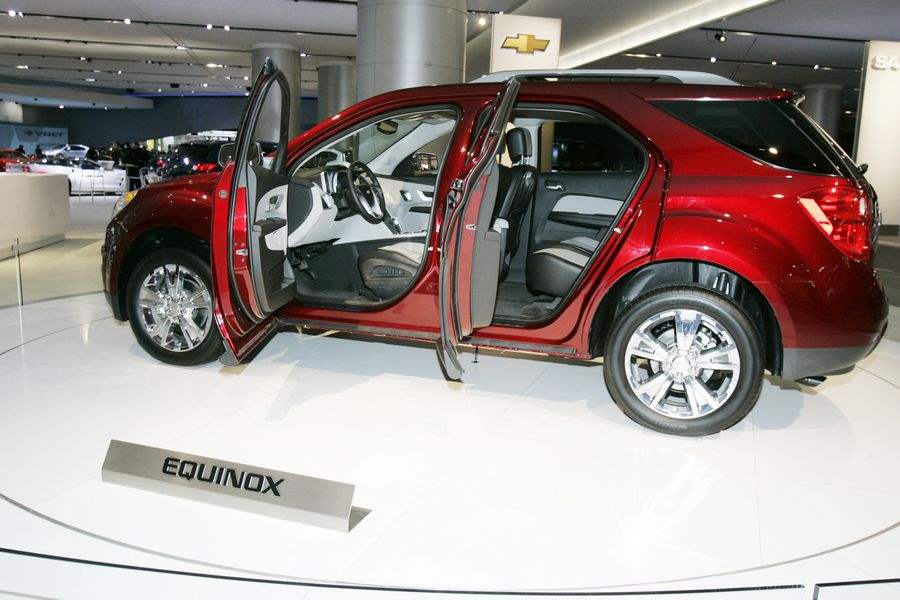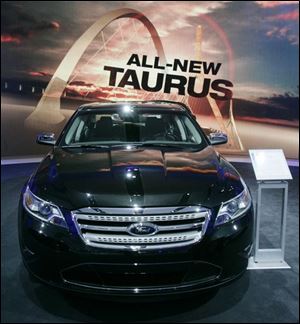
Engineers press for efficiencies drop by drop
1/15/2009
The 2010 Chevrolet Equinox was designed with a vertical pillar in the liftgate to help reduce wind resistance and therefore increase fuel efficiency.
The Blade/Lori King
Buy This Image

In a 2010 Lincoln MKS, Ali Jammaol, an engineer with Ford Motor Co., demonstrates the vehicle's self-parking function he helped design. Its steering system uses an electric motor rather than hydraulics.
DETROIT - Pete Reyes sees it in a futuristic light bar on the front corners of the 2010 Ford Taurus he helped design.
Bob Reuter points with pride to an unassuming vertical line on the liftgate on his 2010 Chevrolet Equinox.
Ali Jammaol talks about how electricity instead of hydraulics puts the power into the power steering of the new 2010 Lincoln MKS.

The 2010 Chevrolet Equinox was designed with a vertical pillar in the liftgate to help reduce wind resistance and therefore increase fuel efficiency.
As a world fresh from the trauma of record-high gasoline prices awaits production of like electric-drive vehicles, automotive engineers like Mr. Reyes, Mr. Reuter, and Mr. Jammaol have been busy wringing out fuel efficiency 1 or 2 percent at a time.
"You want to have a vehicle that's very slippery, that goes through the air efficiently," said Mr. Reuter, detailing the rear pillar of the new Equinox that he oversaw.
He spoke with the pride of a parent showing off his child's trophy case.
"This edge is there for a very specific reason: It's to break the air flow as it goes around the rear of the vehicle.
"The way you integrate the tail lamp, the rear quarter - all of these things are very deliberate, they're not accidental," to improve aerodynamics, he said.

The light bar on the front corners of the 2010 Ford Taurus helps save fuel by reducing the load on the engine of the redesigned flagship sedan.
Being an automotive engineer today is about much more than modeling clay and space-aged shapes. Increasingly it's about software and materials and a drive to plug the internal combustion engine's efficiency leaks.
"It's not all steel," Mr. Jammaol said from behind the leather-wrapped steering wheel of the Lincoln as he demonstrated the vehicle's ability to parallel-park itself.
"All of these energy losses are gone now, because [the steering system is] driven by an electric motor," he said. "We gain 3 to 5 percent [fuel efficiency] by switching from hydraulics."
Within each new vehicle introduced on the floor of the 2009 North American International Auto Show is a balance struck by engineers trying to satiate customers' competing desires for fuel economy and unbridled power.
Mostly, the negotiations that set the balance happen years before the first customer ever slips behind the wheel.
"It all starts with what you want the vehicle to be," explained Mr. Reyes, the chief engineer behind Ford's new flagship sedan, the 2010 Taurus.
He was talking about the countless market studies and customer research that go into a vehicle before an engineer ever picks up pencil.
Ford Motor Co. engineers tried to gain efficiencies wherever they could, like reducing the motor's electric load and cutting drag with styling, he said
"These light bars look great and they're really progressive," Mr. Reyes said.
Engineers and executives in a cash-strapped industry don't have the luxury to chase fanciful dreams anymore and can't afford to get the balance wrong if they want their vehicles to sell.
"It's obviously a challenge when you're in a resource-constrained world," Frank Klegon, Chrysler LLC's product development chief, said in an interview this week during the media previews to the Detroit auto show, which opens to the public Saturday.
"The market and the consumer are flexible from the perspective of what they want and what they need, and because the demand curve changes instantaneously, it appears, as good as we are, we're not that instantaneous," he said.
From July to December, the nationwide average price for a gallon of gas fell 58 percent from $4.11 to $1.74, creating a huge problem for automakers trying to decide what to design or build to match consumer demand.
Automakers around the world continue to pursue everything from electric and hydrogen-powered cars to hybrid gas-electric cars to improved fuel economy for the internal combustion engine.
"Part of it is you have to look at what you think long-term trends are going to be, and I think on a long-term trend basis the cost of gas is going to be higher rather than lower than it is today," said Jim Lentz, president of Toyota Motor Sales USA.
The Blade's news services contributed to this report.
Contact Larry P. Vellequette at:
lvellequette@theblade.com
or 419-724-6091.